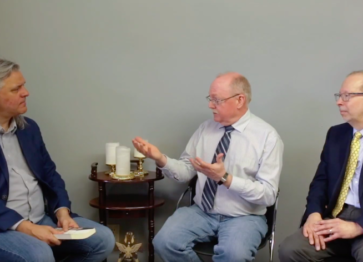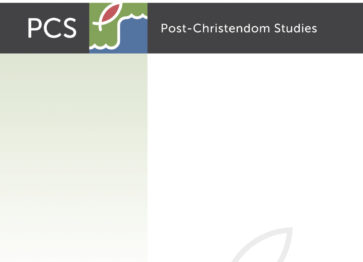Rod Dreher, a senior editor for The American Conservative, is garnering attention for The Benedict Option: A Strategy for Christians in a Post-Christian Nation (Sentinel, 2017), a book that expands upon his earlier blogging on the same topic. The basic idea is that in the post-Christendom U.S., shouldn’t Christians
quit piling up sandbags and . . . build an ark in which to shelter until the water recedes and we can put our feet on dry land again? Rather than wasting energy and resources fighting unwinnable political battles, we should instead work on building communities, institutions, and networks of resistance that can outwit, outlast, and eventually overcome the occupation (12).
Dreher invokes Benedict’s name for this strategy, via Alasdair MacIntyre’s hope that another Benedict would lead the church (as Dreher puts it) “to build arks capable of carrying them and the living faith across the sea of crisis—a Dark Age that could last centuries” (18), not unlike the first Benedict did as the Roman Empire fell. With Benedict and his monastic Rule as models for “strategic withdrawal” (2), Dreher explores the Rule itself as well as communities where its virtues are being creatively practiced. Along with the already noted uses of the image of the ark, Dreher often turns to “exile” as expressive of Christian experience in contemporary American culture. Both metaphors describe the cloistered existence that Dreher commends, though they might also re-inscribe entrenchment in situations where that might be less necessary or helpful.
Dreher’s argument has significant blind spots. He opposes LGBTQ+ concerns so thoroughly that this often becomes the book’s controlling issue; does he really believe that the culture wars are over? He offers vignettes of what his Option looks like, concerning politics, education, or technology, but never explains completely what the Option is, or how a Benedict-Option community actually functions. And as I noted in an article with applications for New Monastic and evangelical theology (in the Canadian Theological Review 4.1 [2015]: 48–58), Dreher’s Option is so withdrawal-focused that it neglects dialogue with other monastic options—some of which have been voiced in (gracious) opposition to Dreher’s earlier Benedictine blogging (e.g., John Hawthorne’s “Patrick Option,”1 evoking St. Patrick’s contextually sensitive, self-emptying mission), while others, such as New Monasticism, have engaged MacIntyre’s work so thoroughly that Dreher’s omission of them seems like reinventing the monastic wheel.2
Even more problematic is Dreher’s scattershot approach to Scripture. As I observe in a forthcoming review in Faith Today (September/October 2017), he consistently applies the term “biblical”—as in “biblical” Christianity and “biblical” views of sexuality—but disregards the very “biblical story” that is central to spiritual (especially monastic) formation. A more disciplined hermeneutic is not too much to ask for in a project like The Benedict Option. Take, for counterexample, Manuela Scheiba’s article, “The Transforming Power of Sacred Scripture in the Rule of Saint Benedict,” in the American Benedictine Review 64.4 ([Dec 2013]: 384–403). In twenty pages, Scheiba produces deeper engagements with Scripture and the Rule than Dreher does in his entire book—not because her approach is more scholarly, but because she reads both together. Where Dreher’s Option “draws on the virtues in the Rule to change the way Christians approach politics, church, family, community, education, our jobs, sexuality, and technology” (Benedict Option, 77), Scheiba doesn’t extract virtues; she observes what Scripture is doing, both in and by means of the Rule. She comments, for instance, “By applying the image of an internal remedy, Benedict indicates how we should ‘work’ with biblical texts and images,” such that “the Bible may unfold its healing power, intensifying our awareness of God’s presence in our life and shaping our attitude in the light of this healing presence. This might result in a call to conversion. . . . to resume a disrupted dialogue, our permanent conversation with Christ in prayer” (“Transforming Power,” 392). Amen. Had Dreher been this intentional in reading Scripture alongside Benedict, or had he at least found a biblical text to anchor his proposal—Paul’s gospel-citizenship concerns in Philippians, say, or a more nuanced use of the Old Testament’s imagery of exile—then the “ark” of his argument might not seem lost at sea.
Endnotes
1. http://johnwhawthorne.com/2015/08/03/the-patrick-option, accessed July 11, 2017. Hawthorne’s post also notes (and contains hyperlinks to) proposals of Options patterned after St. Dominic and the biblical Jeremiah; each of these, like Hawthorne’s Patrick Option, is markedly and deliberately less secessional than the Benedict Option.
2. See the work of Jonathan R. Wilson, as referenced in my article noted above, especially p. 57 and footnotes 41–42.
*The views and opinions expressed in this article are those of the author and do not necessarily reflect the official policy or position of McMaster Divinity College or the Centre for Post-Christendom Studies.*




